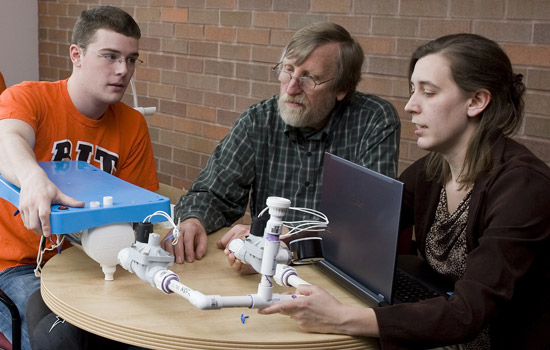Professor makes clean water in Mexico a priority
John Waud facilitates installation of UV water-treatment systems in region
A. Sue Weisler
Graduating seniors from RIT’s Kate Gleason College of Engineering focused their yearlong senior design project on improving water-treatment kiosks like the one professor John Waud, center, installed in Chiapas, Mexico. Here, Matt Switzer, left, explains a design improvement to Waud and Sarah Brownell, adjunct professor and project guide/mentor to multidisciplinary design teams of senior engineering students.
John Waud knows first hand the cost of clean water in Chiapas, Mexico.
The environmental science professor at Rochester Institute of Technology and his wife, Doris, a teacher at Fyle Elementary School in Henrietta, have spent part of every summer for the past 12 years doing conservation work along the region bordering Guatemala. The Perinton couple also lived there for a year on sabbatical in 2004–2005.
The Wauds will return to Chiapas in July. They will continue their conservation work in the riparian valleys of the coastal zone and their efforts to make affordable drinking water available in the villages.
The Wauds and the congregation at Christ Clarion Presbyterian Church donated $6,000 to install a drinking-water treatment system last June in the village of Nueva Flor. They worked with the nonprofit organization Fundación Cántaro Azul (Blue Jug Foundation) to provide the underserved village a water disinfection system using ultraviolet radiation.
Last summer, Waud and Rev. Jack Heister from Christ Clarion Presbyterian Church traveled part way up the Sierra Madre de Chiapas Mountains to Nueva Flor. They met up with their contacts from the Blue Jug Foundation and Waud’s longtime conservation colleague Omar Gordillo from the Comisión Nacional de Áreas Naturales Protegidas (the National Commission on Protected Natural Areas). The team installed the UV water treatment system and trained the village residents to operate and maintain it.
The unit—which disinfects five liters of water per minute—accommodates approximately 500 people and provides a reliable source of water during emergencies. The community kiosk gives residents of Neuva Flor an alternative to purchasing expensive bottled water.
“They were paying 19 pesos, or $1.50 to $2, for 19 liters,” says Waud, a professor in the Thomas H. Gosnell School of Life Sciences in RIT’s College of Science. “That price has gone down to 5 pesos, and that price includes a little money they are taking off the top to put aside for schools and health care. The lower price becomes really significant in a world where $5 a day is a typical wage.”
The UV water-treatment system uses double the EPA-recommended fluence of 400 joules per square meter of ultraviolet radiation to prevent pathogens from reproducing and to compensate for poor water conditions and power fluctuations. The gravity-fed design is based on a system developed by students at the University of California at Berkeley.
“We have received some funding and are preparing additional requests,” Waud says. “We expect to install approximately five systems over the next three years in the same general area of Chiapas. So far, we have funding from Rush-Henrietta Rotary Club, Covington Presbyterian Church and Christ Clarion Presbyterian Church.”
“Fresh water is a concern worldwide,” he adds. “The need in Chiapas is great, both at the coast and in the rest of the state. With the additional funding we hope to obtain, we will begin, in a small way, to address the need for pure drinking water there.”
For more information about the Wauds’ efforts to install UV water treatment systems in Chiapas, contact John Waud at jmwscl@rit.edu.









